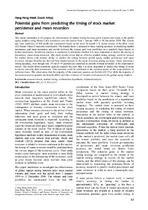Potential gains from predicting the timing of stock market persistence and mean reversion
Abstract
This paper undertakes to investigate the effectiveness of market timing between prior winners and losers in the global
equity markets using Monte Carlo simulation over the period from 1 January 1999 to 31 December 2009. The winner
and loser portfolios of 100 stocks are constructed based on the prior 36-month U.S. dollar returns of the Dow Jones
(DJ) Sector Titans Composite constituents. The market timer is assumed to have varying accuracy in predicting market
persistence and mean reversion, and switch between the winner and loser portfolios on a quarterly basis based on
his/her predictions. Sensitivity analysis is conducted to determine whether it is more important to predict the timing of
persistence versus mean reversion. The study results reveal that an effective market timing strategy could be devised
for market timers with modest ability to predict the timing between global equity market persistence and mean
reversion. Greater benefits are derived from improvements in the mean reversion timing accuracy versus persistence
timing accuracy, even though only 19 out of 44 quarters are classified as periods of mean reversion in the examination
period. The results from sensitivity analysis support the view that it is more important to predict the timing of mean
reversion correctly than persistence. This outcome could be attributed to the resilient nature of the loser portfolio in
turbulent times. The observation that the majority of the persistent quarters are bullish (65.52%) while the majority of
the mean reversion quarters are bearish (60%) provides evidence of investor overreaction in the global equity markets.

